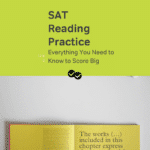So here’s the skinny: there will always be two sets of dual passages, one short (35-30 lines total) and one medium to very long (60-90 lines).
What exactly is a dual passage? Well, just as its name implies it is a set of two passages written on a similar topic. The passages usually do not agree completely with one another, but sometimes they will agree with major aspects of an issue but have a different focus than the other.
Let’s first start with a short dual passage. They are less complex because of their lengths, but what I’ll talk about for the short passages applies to long passages. Then, at the very end, I’ll talk about some particulars of long dual passages.
Short Dual Passage Excerpt
Passage 1
I will grant Fitzgerald this much: Somehow, in the five years between his literary debut and The Great Gatsby, he taught himself to write. This Side of Paradise is intermittently brilliant but terrifically uncontrolled. Gatsby, by contrast, is focused and deliberate: a single crystal, scrupulously polished. It is an impressive accomplishment. And yet, apart from the restrained, intelligent, beautifully constructed opening pages and a few stray passages thereafter, Gatsby as a literary creation leaves me cold. Like one of those manicured European parks patrolled on all sides by officious gendarmes, it is pleasant to look at, but, like the pages of Fitzgerald’s work, you will not find any real people inside.
Passage 2
One of the main charges that has been leveled against The Great Gatsby is that the characters are either one-dimensional stereotypes or as ethereal as one of Jay Gatsby’s many soirees. While this assertion carries some truth, it both misses much of what Fitzgerald set out to do in The Great Gatsby, and the literary aesthetic necessary to pull it off. The 1920’s flappers were themselves playing a part, one that did not allow for much introspection. Even Jay Gatsby at his most confessional inhabits a role he has artfully crafted. Perforce, Fitzgerald must create characters who are not wrestling with existential doubts, and who must somehow rise above them, but who serve as a backdrop for a time and a place.
You might think this is an awful lot to read, but the above is actually a short dual passage. Regardless of whether the passages total 15 lines or 25, each short dual passage will be followed by exactly four questions. Most of the times, half the questions will deal with both passages, and half the questions will deal with just one passage. Sometimes, you’ll get three questions dealing with both passages. In general, questions dealing with both passages tend to be more difficult than questions dealing with just one passage. It makes sense, right? Comparing what two people are saying is never easy.
Here is an example of just such a question:
How would the author of Passage 2 most likely respond to the assertion in the last line of Passage 1 that “you will not find any people inside”?
(A) Not all characters in The Great Gatsby lacked emotional depth.
(B) Many of the characters in The Great Gatsby are caricatures of actual living people.
(C) The Great Gatsby focused more on prose style than on character development.
(D) Jay Gatsby was a fully formed character, one that evolved throughout the course of the novel.
(E) In aiming to depict a certain type of person, Fitzgerald had to sacrifice character depth.
To answer this question, you will not only have to read both passages, but will also have to have a good idea of what each author is talking about.
#1 – Get the big picture of both passages (as you read)
#2 – Understand how the passages disagree and, when it applies, how they agree (again, as you read you should be on the look out for this)
#3 – Answer question by going back to the passage, finding relevant information, and then phrasing a response based on the text
Application
Let’s take apart the question above.
First off, let’s assume you’ve followed steps 1 and 2, and so you have a pretty good idea what the passages are about and how they relate to each other. Now, let’s take a look at the question: the quote is taken from the part of Passage 1 that talks about how the book is well-written but in one of those too-perfected garden where people can’t walk. Notice as well how Passage 1 mentions that “you will not find any real people inside” the book or the garden. At this point, a light bulb should go off in your head: ah, Passage 2 talks about how many of the characters lacked depth (“a role that did not allow for much introspection”).
Explanation
At this point you might by tempted to just choose (A). After all, it does talk about emotional depth. But remember Passage 2 is agreeing that many of the characters are contrived and not authentic (“even Gatsby himself”). So before heading to the answer choices, we should get some text that gives us a better sense of what Passage 2 thinks about the characters being kind of fake. Notice the last sentence. It basically says that Fitzgerald had to make characters lacking depth because their real function was to capture a time and place.
Now that we have figured out how Passage 2 would respond, we have to home in on the right answer. (B) is very tempting because of the first few words. But notice the end: “actual living people”. The passage never says this—and you shouldn’t infer that just because Fitzgerald was using characters to capture a time and place that these characters represented actual people.
(C) is also very tempting (that’s why it’s so important to come up with the answer by going back to the passage). (C) is wrong because Passage 2 never mentions “prose style”. Only Passage 1 does.
(D) is clearly wrong since Passage 2 says that Gatsby is playing a part. There is mention of how, if at all, he evolved in the novel.
(E) may not jump off at the page at you, as is the case with many correct answers. The test writers have to reword what the text is saying so getting the right answer is not about identifying a familiar word, but rather decode the words in the answer choice to see if they match the ideas in the passage. It is the wrong answers that take words directly from the text, and package them in such a way that they are not supported by the passage, yet the answer jumps out at you and implores deceptively, “Pick me.”
Okay, so that was quite a lot of info. for one question. But in showing you the steps, and then taking a really hard question, you should be ready for the majority of dual passages (as long as your general comprehension is up to snuff!).
The Dual Passage
Now for the long dual passage. First off, I’m not going to excerpt a long dual passage (too many trees would be murdered in the process). Rather, I’m going to talk about how the strategy for long dual passages builds upon what we learned in short dual passages.
What you need to know
The long dual passage usually has thirteen questions. On average four of these will apply to both passages, though sometimes there will only be three questions and every now and then, there will be as many as five.
Once in awhile an SAT will have a long dual passage that has fewer than 13 questions. I’ve seen 9 and 10 question long dual passages. These passages tend not to be as long as the 13-question dual passages, though sometimes you can get as many as four questions that apply to both passages.
Strategies
#1 – Notes
Make sure you are taking either mental notes or written ones, so that you can pick up on the issue being discussed in both passages, and how the passages are different/similar. Only, following this method with the long dual passages is going to require a lot more brainpower—and a lot more practice.
One good trick is to write, in the margins of the text, a few-word summary for each paragraph. Your goal is to be able to pick up the main ideas from each paragraph (something you should do by focusing on the topic sentences), and not get lost in the swamp of words.
#2 – Compare passages
Once you’ve written in little mini-summaries, it should be much easier to compare passages. Ultimately, you want to be able to process the passage in your head.
Doing so shouldn’t take too much time, and indeed will save you a lot of time when you get a question dealing with both passages. You won’t find yourself going back through both passages and floundering about looking for the relevant information.
#3 – Answer both passage questions first
Since you’ve just been reading about both passages, it is a good idea to try to answer questions applying to both passages. If you struggle to do so, just come back to them. This step isn’t too important, and you might find that answering the questions one after the other works best for you.
#4 – A passage at a time
This strategy is ONLY for those who slow readers. If this sounds like you, then read just one passage at a time and answer the questions that relate to the passage 1. Questions are always in “chronological order”, meaning that you’ll get all the questions dealing with passage 1 first. Though a general question relating to just one passage or even one relating to both passages may pop up, just skip and come back to it later, if you have time
And that is the whole point of this strategy. It will allow you to answer at least those questions dealing Passage 1. You don’t want to run out of time because you read both passages, and therefore only get to answer a few of the questions.
Takeaway
The main point here is practice, practice, and more practice. Dual passages are not easy, and require you to store a lot of information in your head at one time. But if you stick with it, you’ll start to get better at these passages.






Leave a Reply